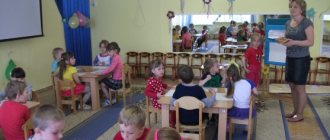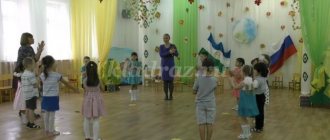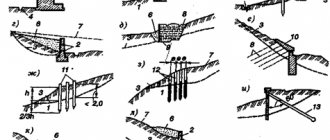Goal: Testing mathematical knowledge in a playful, entertaining form: in counting, the ability to independently complete tasks in a competitive environment.
Objectives: Educational: Learn to solve problems involving increasing and decreasing a number by several units. Strengthen counting within 8, knowledge of numbers up to 8. Developmental: Form in children ideas about the relationships of numbers in a number series, identify and name the previous and subsequent ones in relation to the named number (numbers and “neighbors”). Develop attention, memory, thinking. Educators: Develop the ability to work in a team, provide assistance, support, endurance and patience.
Materials, tools, equipment: Demonstration material: a set of numbers from 1 to 8, cubes, 3 hoops, multi-colored apples made of colored paper. Handouts: geometric shapes, cards with numbers.
Vocabulary work: Digital city, numbers “neighbors”, travel, right, left, below, up, around, previous, next.
Preliminary work: introducing children to the number and number 8, time of day, problem solving.
Methods and techniques: game motivation, questions for children, explanation, instructions for implementation, practical actions of children, musical accompaniment, didactic games.
OOD progress:
1. Organizational moment Communicative exercise “Hello.” Educator. Today we are going to the amazing country of Mathematics. In the capital of the country of Mathematics - Digital City - we will play, count and solve fun problems. And to get to the country of Mathematics, you need to close your eyes and say the magic words: “1, 2, 3, 4, 5 We begin to play! We close our eyes, We find ourselves in the country of Mathematics! (the teacher puts on a cape, a crown, turns into a fairy Mathematics) Fairy. I am glad to welcome you to my city Tsifrograd! But you can't just come here. You need to solve fun problems and show the answers in numbers.
2. Warm up. Solving problems involving increasing and decreasing a number by several units. 1) How many boots did Olya buy so that the cat wouldn’t get her paws wet? (4) 2) Seryozhka fell into the snow, and behind him - Alyoshka, And behind him - Irinka, and behind her - Marinka, And then Ignat fell, How many guys are there in the snow? (5) 3) On Andryusha’s saucer are four yellow pears. The child wanted to eat, and he ate one of the pears. Now count the pears on Andryusha's saucer. (3) 4) A hedgehog walked through the forest, Found mushrooms for lunch: Two under a birch tree, One at an aspen tree, How many of them will there be in a wicker basket? (3) 5) Five puppies Plus mother - husky. How much will? Count it up! (6) 6) Six cheerful bear cubs are rushing into the forest to pick raspberries, But one baby is tired, Has fallen behind his comrades, And now find the answer: How many bears are ahead? (5) (cards with numbers are arranged on a magnetic board in a different order) Fairy: Guys, you solved the problems correctly! Therefore, I invite you to the land of Mathematics. Do you know that bears in my country love mathematics, they know how to solve problems, add and subtract, and also have fun and play. I invite you to play too.
Physical education minute. Song of a teddy bear (ry - ra - ru).
3. Didactic game “Fold the house.” Fairy: One bear cub, in my country, does not have his own house. He knows a lot of geometric shapes and wants to build a house out of them, but doesn’t know how. Shall we help him? Geometric shapes are waiting for you on the table. Fairy: You have created wonderful houses! What geometric shapes did you use? There are so many houses, but only one bear. He will choose a house for himself, but what to do with the rest of the houses? Can I give these houses to the residents of my fairy-tale country?
4. "Game with apples." Fairy: The bear already has a house, but let's treat the bear with apples. Apples are not simple, with different numbers of seeds inside. You will run to the music, and as soon as it stops, take one apple at a time. Count the seeds in the apples and stand near the number in the hoop. How hard you tried! All the apples have been collected. Tired. It's time to relax!
5. Physical education (with musical accompaniment)
6. Didactic game “Live numbers”. Fairy: Have you rested? And in my country, Mathematicians, there are living numbers. Do you want to play with them? Cards with numbers are laid out on the table. Children take them and insert them in order from 1-8. The teacher suggests making a count: quantitative, reverse. Tasks: - Show the “neighbors” of the number 5 and name them. - Show the “neighbors” of the number 7 and name them. - Show the number 1 more than 2. - Show the number 1 less than 4. - Show the number before the number 8. - Show the number after the number 5. - Show the number to the right of the number 4. - Show the number to the left of the number 7.
7. Didactic game “Find the number.” (children stand in 2 teams) Rules of the game: Come to me! There are cubes in front of you. Yellow cubes and green cubes. I'd like you to count them. And to do this you need to split into two teams. Team 1 goes around the yellow cubes and counts them. Team 2 goes around the green cubes and counts them. Each participant takes a card with a number corresponding to the number of cubes passed. Team 1, show cards with numbers. How many cubes? How to check who counted correctly? 2nd team, show cards with numbers. How many cubes? How to check who counted correctly?
8. Reflection. Fairy: Guys, you completed all the tasks! Well done! We will continue to meet with you, but now it’s time for me to leave, and it’s time for you to return. Close your eyes. 1, 2, 3, 4, 5 We're done playing. We close our eyes and leave the fairy tale!
Educator: Our journey has ended. Where have you been? What did you like about the country of Mathematics?
Author: Marina Evgenievna Levicheva, teacher, GBOU school No. 842, preschool department building 137, Zelenograd, Russia
The article is published in the author's edition
Math entertainment summary for kindergarten. Senior - preparatory group
Summary of entertainment for senior and preparatory groups.
“In search of treasure in the land of mathematics” Program content: Educational area “Cognition”: Continue to teach children to count from 1 to 10 and back. Continue learning to classify geometric shapes by shape and color. Develop the ability to navigate on a sheet of paper and move in a given direction (forward, left, right). Develop the ability to correctly use the names of the parts of the day. Promote the development of logical, spatial thinking, attention. Integrated areas: “Socialization” - to cultivate mutual assistance and a desire to help others in children.
“Communication” - improve the dialogical form of speech. Progress of the lesson
Children in the group read a letter from the Queen of Mathematics, who invites them to find a treasure in her kingdom. Children with a teacher come to the music room and in front of them there is a screen that looks like a castle, decorated with numbers and geometric shapes. Educator. Guys, look at some kind of lock in front of us, let's knock. They knock. Voice from behind the screen. Who's there? Children. We are the children of the cherry group looking for treasure. Voice from behind the screen. Hello, my name is Mathematics, I will help you find the treasure, but you must complete the math tasks. We agree. Children. Yes. 1 TASK. MATHEMATICS. Put on my amulets with numbers together without arguing, because in my mathematical family they love order. (amulets with numbers hang on the screen). Children wear amulets with numbers from 1 to 10. Mathematics praises children. Well done for completing my task. 2 TASK. MATHEMATICS. My amulets will help you play the game “Live Numbers”. Educator. I know this game, explains to the children how to play it. Game “Living Numbers” - children run around the hall to the music, then line up in order (from smallest to largest) from 1 to 10 (According to the numbers of the amulet), then vice versa from 10 to 1. (from highest to lowest) The teacher asks mathematics, Mathematics, we completed your task. Mathematics. Well done. 3 TASK. Mathematics. Now answer the questions from my square. Questions. 1. How many suns are there in the sky? 2. How many eyes does an elephant have? 3. How many days are there in a week? 4. How many legs do two ducklings have? 5. Which is lighter: a bag of cotton wool or a bag of sugar? 6. How many fingers do the two boys have? 7. How many ears do three babies have? 8. How many colors does the rainbow have? 9. How many tails do seven cats have? Mathematics praises children. 4 TASK. Mathematics. Game say in reverse. Throws a ball from behind a screen. Here's a math ball for you. The game is played with a ball. The teacher throws the ball to the child and names one of the mathematical concepts, and the child throws the ball back and names the opposite of the named concept. Long short; Big small; High Low; Wide narrow; Fat slim; Far close; Above - below; Left - right; Back and forth; One is many; Outside - inside; Light heavy. Mathematics praises children. 5 TASK, mathematics. And now the problems from my sister are arithmetic. The teacher reads the tasks. 1. There were two apples and seven pears on the table. How many vegetables were on the table? 2. On one shore there is a chicken, on the other there is a duckling, in the middle there is an island. Who will swim to the island faster? 3. . Four goslings and two ducklings are swimming in the lake and screaming loudly. Well, quickly count, How many babies are there in the water? (Six) 4. . The mother goose brought six children to the meadow for a walk. All the goslings are like balls: Three sons, and how many daughters? (Three) 5. Natasha has five flowers and Sasha gave her two more. Who here can count, What is two and five? (seven) 6. Seven cheerful piglets stand in a row at the trough. Two went to bed to go to bed - How many pigs are there in the trough? (Five) 7... The goblin collected 10 fly agarics, and Baba Yaga collected 8 fly agarics less. How many useful mushrooms did Leshiy and Baba Yaga collect? 8.. Grandma has a granddaughter Masha, a cat Fluff and a dog Druzhok. How many grandchildren does grandma have? Educator. Mathematicians, our guys coped with the task. Mathematics praises children. 6 TASK Mathematics, and now you need to sit down at the tables and complete a geometric dictation. “Geometric dictation. (children sit at tables) (In front of each child there is a square sheet of paper). Educator. -Show the sheet the top, bottom, left side, right side. Place a circle in the upper right corner. In the lower left corner - a rectangle. In the upper left corner there is an oval. In the lower right corner is a square. Now take the right pencil and draw your favorite figure in the middle. Mathematics praises children. 7 Task. Mathematics, well, now I invite you to go fishing. Game “Fishing” (you need to catch a fish on which the number is one less than your amulet) From a given landmark, children run to the place of the lake, find their fish and return to the place. Mathematics praises children. 8 TASK. Math, game find your brother, and your brother is 1 more than your number on the amulet. There are 11 hoops on the floor. The teacher places a card with a number from 1 to 11 in the center of each hoop. Children dance to music between the hoops. When the music stops, the children take their places in the hoops with a number one greater than their number amulet.. Mathematics praises the children. Task 9. Geometric family. Children understand geometric shapes, square, triangle and circle. One, two, three, spin around and match the colors (you get 3 colors of purple, 4 colors of yellow, 3 colors of blue). One, two, three, spin around and get the shape of the figure (3 squares, 4 circles, 3 triangles) One, two, three, turn around and get together in size. There must be some big ones and some small ones. Mathematics comes out from behind the castle screen, praising the children. Mathematics, well done guys, you deserve your treasure, so here is the last task. Stand with your back to the window 4 steps forward, 2 steps to the right, here is your treasure (children find a chest with treats and say goodbye to mathematics).
We recommend watching:
Summary of GCD in the middle group for FEMP on the topic “Fun Mathematics” Summary of GCD for FEMP. Senior, preparatory group. Generalization of knowledge about geometric shapes Notes on mathematical development in the middle group Manual on FEMP. Junior-middle group
Similar articles:
Work program for the subject “Introduction to Mathematics” for primary preschool age
Summary of an integrated lesson in the senior group of kindergarten on the topic: Riddles
Abstract of GCD in mathematics in kindergarten in the senior group on the topic “Vertex, angle, side of a geometric figure”
Summary of a lesson on FEMP in the senior group of a preschool educational institution. Topic: “Composition of a number of units (number 7)”
Lesson notes on FEMP in the senior group. Count within 7
Summary of mathematical leisure in the senior group “Journey to the Land of Mathematics”
Summary of mathematical leisure in the senior group
"Journey to the Land of Mathematics"
Target:
Testing mathematical knowledge in a playful, entertaining way: in counting, the ability to independently complete tasks in a competitive environment.
Objectives:
Educational:
Learn to solve problems involving increasing and decreasing a number by several units. Maintain counting within 8, knowledge of numbers up to 8.
Developmental:
To form in children ideas about the relationships of numbers in a number series, to identify and name the previous and subsequent ones in relation to the named number (numbers and “neighbors”).
Develop attention, memory, thinking. Educators:
Develop the ability to work in a team, provide assistance, support, endurance and patience.
Material, tools, equipment:
Demonstration material: a set of numbers from 1 to 8, cubes, 3 hoops, multi-colored colored apples. Handouts: geometric shapes, cards with numbers.
Vocabulary work:
Digital city, numbers “neighbors”, travel, right, left, below, up, near, previous, next.
Preliminary work:
introducing children to the number and number 8, time of day, problem solving.
Methods and techniques:
game motivation, questions for children, explanation, instructions for implementation, practical actions of children, musical accompaniment, didactic games.
OOD progress:
Organizing time
Communicative exercise “Hello.” Educator. Today we are going to the amazing country of Mathematics. In the capital of the country of Mathematics - Digital City - we will play, count and solve fun problems. And to get to the country of Mathematics, you need to close your eyes and say the magic words:
“1, 2, 3, 4, 5 Let's start playing! We close our eyes, We find ourselves in the country of Mathematics! (the teacher puts on a cape, a crown, turns into a fairy Mathematics) Fairy. I am glad to welcome you to my city Tsifrograd! But you can't just come here. You need to solve fun problems and show the answers in numbers.
2. Warm up.
Solving problems involving increasing and decreasing a number by several units. 1) How many boots did Olya buy so that the cat wouldn’t get her paws wet? (4) 2) Seryozhka fell into the snow, and behind him - Alyoshka, And behind him - Irinka, and behind her - Marinka, And then Ignat fell, How many guys are there in the snow? (5) 3) On Andryusha’s saucer are four yellow pears. The child wanted to eat, and he ate one of the pears. Now count the pears on Andryusha's saucer. (3) 4) A hedgehog walked through the forest, Found mushrooms for lunch: Two under a birch tree, One at an aspen tree, How many of them will there be in a wicker basket? (3) 5) Five puppies Plus mother - husky. How much will? Count it up! (6) 6) Six cheerful bear cubs are rushing into the forest for raspberries, But one baby is tired, Has fallen behind his comrades, And now find the answer: How many bears are ahead? (5) (cards with numbers are arranged on a magnetic board in a different order) Fairy: Guys, you solved the problems correctly! Therefore, I invite you to the land of Mathematics. Do you know that bears in my country love mathematics, they know how to solve problems, add and subtract, and also have fun and play. I invite you to play too.
Physical education minute.
Song of a teddy bear (ry - ra - ru).
3. Didactic game “Fold the house.”
Fairy: One bear cub, in my country, does not have his own house. He knows a lot of geometric shapes and wants to build a house out of them, but doesn’t know how. Shall we help him? Geometric shapes are waiting for you on the table. Fairy: You have created wonderful houses! What geometric shapes did you use? There are so many houses, but only one bear. He will choose a house for himself, but what to do with the rest of the houses? Can I give these houses to the residents of my fairy-tale country?
4. "Game with apples."
Fairy: The bear already has a house, but let's treat the bear with apples. Apples are not simple, with different numbers of seeds inside. You will run to the music, and as soon as it stops, take one apple at a time. Count the seeds in the apples and stand near the number in the hoop. How hard you tried! All the apples have been collected. Tired. It's time to relax!
5. Physical school
(with musical accompaniment)
6. Didactic game “Live numbers”.
Fairy: Have you rested? And in my country, Mathematicians, there are living numbers. Do you want to play with them? Cards with numbers are laid out on the table. Children take them and insert them in order from 1-8. The teacher suggests making a count: quantitative, reverse. Tasks: - Show the “neighbors” of the number 5 and name them. - Show the “neighbors” of the number 7 and name them. - Show the number 1 more than 2. - Show the number 1 less than 4. - Show the number before the number 8. - Show the number after the number 5. - Show the number to the right of the number 4. - Show the number to the left of the number 7.
7. Didactic game “Find the number.”
(children stand in 2 teams) Rules of the game: Come to me! There are cubes in front of you. Yellow cubes and green cubes. I'd like you to count them. And to do this you need to split into two teams. Team 1 goes around the yellow cubes and counts them. Team 2 goes around the green cubes and counts them. Each participant takes a card with a number corresponding to the number of cubes passed. Team 1, show cards with numbers. How many cubes? How to check who counted correctly? 2nd team, show cards with numbers. How many cubes? How to check who counted correctly?
8. Reflection.
Fairy: Guys, you completed all the tasks! Well done! We will continue to meet with you, but now it’s time for me to leave, and it’s time for you to return. Close your eyes.
1, 2, 3, 4, 5 We're done playing. We close our eyes and leave the fairy tale!
Educator: Our journey has ended. Where have you been? What did you like about the country of Mathematics?





